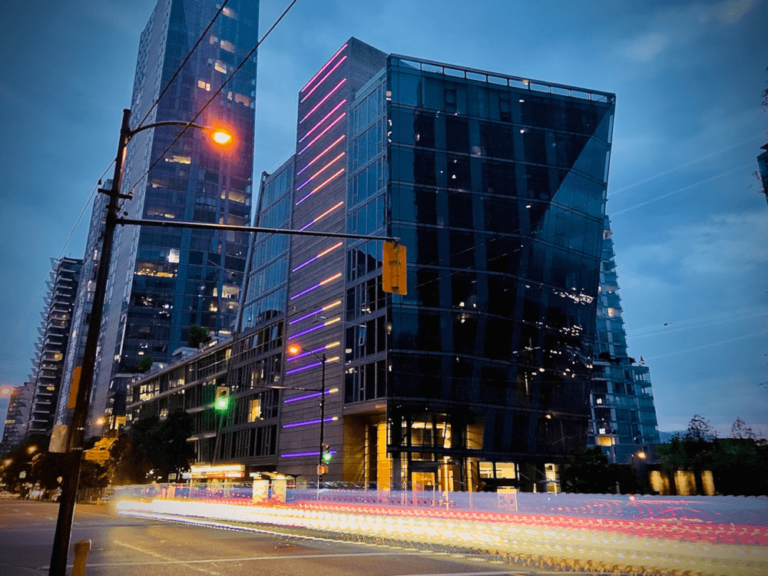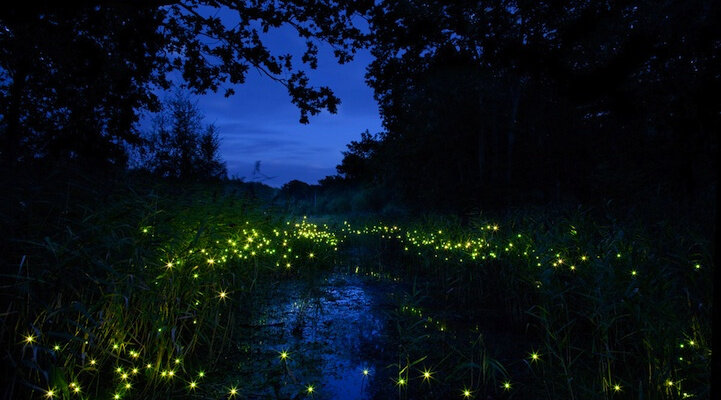Light is one of the most fascinating physical phenomena. Ask both a physicist and a chemist to explain what light is and the exchange will quickly turn into a metaphysical discussion. They would tell you light is electromagnetic radiation behaving both as a wave and a particle. They would state that nothing moves faster than light. That there is a large spectrum of light in the universe but that the human eye can only perceive a very limited amount of that range. To this they would add that the distance between each wave allows our eyes to create colour in our brains and that even when it is dark, light is still around us. In this sense, light is the only phenomenon that connects us with the universe, with space and with time because by studying the radiation of astronomical bodies, we can actually look back in time reaching to the beginning of existence itself.
This is all utterly fascinating and even more so, is the ungraspable search to understand light and the attempt to control it. I feel that this elusive understanding is sometimes felt within art as well. Just like devoted scientists, postmodernist artists have explored the boundaries of art so much that the result has been an alienation of the public and an emergence of a deceptively elitist art. However, the reality is that art has never been so universal and inclusive as it is today. I will not deny that non-representational art, abstract art, conceptual art (to mention a few) require some mediation but ultimately a movement like the Light and Space one of the 70s, explored universal concepts accessible by all. Surely there is nothing more universal than light, is there? And yet, nothing is more ephemeral and intangible than this ‘medium’. Robert Irwin, Mary Corse, Helen Pashgian, James Turrel amongst others, preceded younger artists like the notable Olafur Eliasson. This succession of artists exploring the experiential characteristics of light, find a continuity in the work of dutch artist Tamar Frank.

In the heart of Coal Harbour, two south-facing towers at 1499 West Pender act as the surface for Frank’s permanent light installation. The shorter 40-meter tower is synchronized to the daily 7pm cheer in Downtown Vancouver since March 13th, 2020. Right before 7pm one can normally hear a boat horn from the nearby harbour. The blast is followed by the 9 o’clock gun explosion (now also synchronized to 7pm) and then, a flood of pot-banging, euphoric yelling, clapping and car horns follow. With it, a quiet and discrete dance of light kindle the concrete chore of the east tower at West Pender Place where light performs before one’s eyes until 11pm. The long duration of the program turns this installation more into a presence rather than a performance. However the light is in constant change. At 10pm when the sun is gone and the backdrop is dark enough, the eight-meter-long horizontal LED lines become red and start mimicking the motion of a heartbeat. Frank created this heartbeat to honour the continuity of life and the relentless fight that we have proved worldwide against the COVID-19 Pandemic.
We invite you to visit the work to notice first hand the captivating colour transitions that mimic nature’s changes; from the cherry-blossom-pinks, to the saturated summer-greens, to the oranges and reds of autumn leaves. Like moss on a tree or coral on the ocean floor, Frank’s installation is incorporated onto the concrete of the building that the structure nests the LED strips in a harmonious manner. Frank masters the interaction of light, space and surface in such a way that the installation becomes one with the architecture. Her work is not only site specific but also time specific and in constant change under her remote surveillance and programming. Normally Frank would be here in Vancouver, examining her artwork and fixing the 120-meter tower. But alas, COVID-19 travel restrictions. No matter thanks to remote control, she can still reschedule the program and modify the movement of the light.
Frank’s light installations are something that you have to live firsthand because your own eyes and brain need to experience that magical retinal and cognitive process that we as humans are capable of doing. This necessary interaction goes hand-in-hand with the Light and Space movement ethos where the public’s perception and participation is intrinsic to the practice.
Light is everything for me since it is the medium I work with. I see it as the source of our visual perception. I like to study it in a way to bring new awareness on how this influences the way we relate to our environment and how we physically and subconsciously orient ourselves.
— Tamar Frank
Tamar’s work often distills the shapes, colours and patterns found in nature. The stripping down of natural phenomena into basic elements is characteristic of her work. In earlier works like in ‘Breuklijn’ (fault line) she captures the minerals in water with rusty orange light and represents the seismological waves caused by tremors with line patterns. The results are captivating artworks that evoke tranquility and invite the viewer to pause and become a participant. With light she creates a contemplative atmosphere to open up emotional narratives that include each and every one of us.
Watch the video below to learn more about Tamar Frank’s current projects and for further insight into her site specific installation at West Pender Place.
Video transcript:
‘Hi, my name is Tamar Frank, I’m a visual light artist based in the Netherlands. Miret and Rebecca from Curated Tastes have invited me to give you some insight into my studio. Currently, I only work here on the weekends because during the week I’m homeschooling my son – like all parents are right now. So in that sense, my situation has changed quite radically (because of COVID-19) and I have a lot less time for my work. When I’m here, I like to do material research for an ongoing project I’m working on and I aspire to work on my website, which I still haven’t found time for yet.’

‘Behind me here, you see a photo of an installation that I made which was constructed of 500 LED lights mounted between the reeds and it’s called Lampyris Noctiluca, and it’s a depiction of fireflies. I’ve used this installation in different festivals and locations but it’s currently being used for the campaign of the National Opera of Paris for the new season of 2020-2021. Instead of the little lights being mounted between the reeds, they were mounted on the empty chairs of the Grand Palais and photographed by Alexis Pichot. Right now, this is all being displayed through social media, and also on posters throughout Paris. If you have the time to go and check that out, please do because it’s very well made and the opera can use all the support it can get, like all other cultural institutions right now.’
‘On the left of me is a light panel that I made for my 20th anniversary. I usually make very large scale site specific installations, but for my 20th anniversary I decided to make something sellable. I made them in a series of 20 and have sold 10 so far, all the proceeds from sales are used for my self published anniversary book which I made, and released about a year ago entitled Light Space, 20 years Tamar Frank.’
‘This book was presented both in Amsterdam and Vancouver, and it displays my work as a retrospective from 1997 to 2017. It shows all my projects but certain projects are highlighted, like the work that I made for West Pender Place, a public art commission, which was commissioned by Reliance Properties. I was actually in the middle of renovating this work last year and we replaced all the fixtures on the lower east tower and we were preparing to replace all the fixtures on the higher west tower this June, but due to the current situation all this has also been moved forward.’
‘Only having the lower tower visible, I decided that I wanted to use the display to make a special program for the healthcare workers. When I presented this idea to my commissioner, I was told that every evening at seven o’clock people go stand on their balconies, open their windows, or stand on their porches and make noise for those on the front line which I think is an incredible display of community, and I wanted to respond to that. So, I made a program that starts at this exact hour. It begins with lines, being scattered all over the building flashing off and on and off, and this visualizes all the individuals inside reaching out to connect. The second part of the program is clapping motion, a very synchronous clapping motion showing us all standing on one line clapping. The final part of the program is a heartbeat motion. The program lasts three minutes all together and the final stage, a heartbeat stage returns again at nine o’clock (update: ten o’clock) in the evening for one minutes and the reason being is that at seven o’clock there’s still a lot of daylight, and this subtle part of the program would probably not be very visible. It’s a very important part of the program because it resembles our hearts beating together, it’s a lifeline, a sign of hope, a beacon, a signal, reaching out saying hang in there, we can do this. I think now the time is more urgent than ever to use art to reach out and connect us. In uncertain times (like this) we as human beings, very much, have a desire to find something, a medium to be able to express our emotions or something to tap into and that is exactly what art does and gives us. It’s something that we can tap into to find solace, to find hope, to find meaning, to find depth, but also to uplift us and to connect us. So, yes, these strange times do connect us, maybe more than before because it also unifies us. We are all in this together and it doesn’t matter where we come from, or what our background is, or what our beliefs are, or what our race is, or our wealth, it doesn’t matter – we are all affected by this. We are all defined for what we are as humans, and human beings and I hope that it makes us more humane. So thank you very much for watching and I hope you enjoyed my little tour. Please take care of yourselves, and each other.’
– Tamar Frank
Tamar Frank, Beuklijn. Public art commission for cultural center Nistelrode, Netherlands. night view (top left) day view (top right)
Website: https://lightspace.org/
Instagram: https://www.instagram.com/tamarfranklightspace/
Facebook: https://www.facebook.com/lightspace74